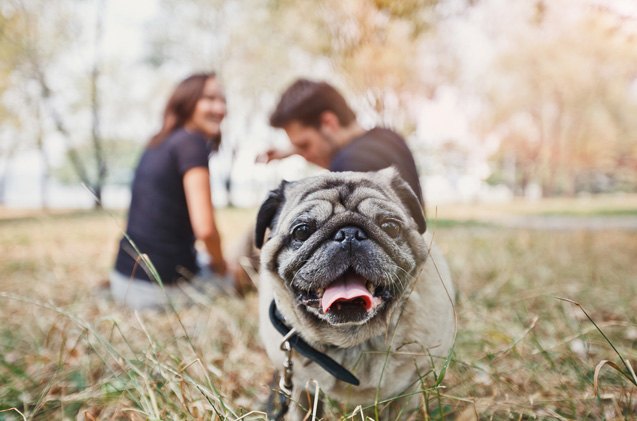Learning About Collapsed Trachea in Dogs

Owners whose dogs suffer from tracheal collapse can tell you that when it happens, it’s a sound that fills you with dread and fear. It’s that honking cough that results when a dog’s airway is obstructed. It kind of sounds like your dog is trying to hack up a hair ball and is often mistaken for reverse sneezing. Let’s talk about collapsed trachea in dogs, what you should know, and what your options are.
The trachea (also known as a windpipe) is made up of hard rings of cartilage and carries air from the nose and throat to small airways (bronchi) that go to the lungs. Tracheal collapse is a common cause of airway obstruction that occurs when these rings of cartilage collapse. Air has to squeeze through this narrowed passageway, which results in a honking cough.
There aren’t any known reasons why this happens, but weak cartilage of the tracheal rings is suspected. This is a congenital abnormality, which means that the dog was born with this health issue. As well, it may be brought about by chronic respiratory disease, Cushing’s Disease and heart disease.
Toy breeds are most susceptible to tracheal collapse, and it occurs in both sexes equally. These breeds include Yorkshire Terriers, Shih Tzus, Pugs, Chihuahuas, Lhasa Apsos, Toy Poodles, Pomeranians and Maltese. Although it can happen at any age, signs and symptoms frequently appear around the age of six or seven.
If you think that your dog has a collapsed trachea, watch for these common symptoms. They may be exacerbated by weight, excitement, heat and exercise.
- Honking cough
- Labored breathing
- Exercise intolerance
- Retching
- Rapid breathing and abnormal breathing sounds
- Bluish tinge to the gums
Signs can vary and include mild to severe panting, respiratory distress and bluish discoloration of the mucous membranes (cyanosis). This can often look like Cushing’s Disease, and your vet needs to check it out. Additionally, your dog may be begging for breath using abdominal muscles, so check to see if they’re tight. Often, dogs with tracheal collapse are frequently overweight, but that isn’t always the case, so don’t rule it out just because a dog is thin. Because tracheal collapse often happens in older dogs, symptoms may include a heart murmur.
Diagnosis
Your vet will typically diagnose tracheal collpase because they’ll be able to get your dog to cough by gently manipulating their neck. To confirm, chest and neck x-rays will be taken and the vet will look at how the trachea changes as your dog inhales and exhales (or tries to).
You may also need to have labwork done to rule out other comorbid situations or conditions, and in some cases, your vet may want to do studies that look at the trachea and lungs during breathing (fluoroscopy or endoscopy). They may also want to take an ultrasound of the dog’s abdomen to see if there is any organ enlargement.
Your veterinarian will be able to go over courses of treatment, depending on the severity of your dog’s tracheal collapse. For mild to moderates cases, your vet will most likely prescribe a treatment of cough suppressants, bronchodilators, antispasmodics, corticosteroid, sedatives, or antibiotics. If obesity is suspected to be the cause of tracheal collapse, weight loss (exercise and change of diet) will be recommended.
There are things that you can do at home to help ease your dog’s symptoms. You can use air filters and purifiers to help get rid of environmental pollutants. And stop smoking in the house or around your dog – in fact, this can be the perfect excuse for you to quit! When walking your dog, use a harness instead of a collar, which can constrict the airway when you apply pressure.
Severe cases of tracheal collapse may require surgical intervention. There are various options, but the most common involves attaching prosthetic polypropylene rings to the outside of the trachea. It is a complicated surgery, but the overall success rates are high and encouraging.
We’ve added a video below of a dog with a collapsed trachea – you’ll notice the honking cough that’s a trademark of the illness.
If you think that your dog suffers from a collapsed trachea, please see your veterinarian immediately. You should never treat your dog with medications without talking to your vet first.

Amy Tokic, Editor of PetGuide.com, is a passionate animal lover and proud pet parent of Oscar, a Shih Tzu/Chihuahua cross, and Zed, a Japanese Chin. Her love of animals began in kindergarten, when she brought her stuffed dog Snoopy into class with her every day. Now, she writes about her adventures in pet ownership and tirelessly researches products, news and health related issues she can share with other animal enthusiasts. In her free time, Amy loves perusing used book and record stores, obsessing over the latest pet products available and chasing squirrels with wild abandon (a habit attributed to spending too much time with her pooches).
More by Amy Tokic























